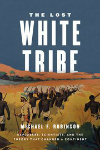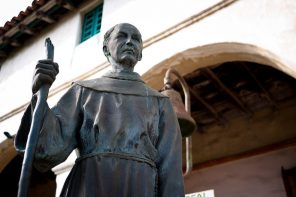Speaking broadly, white supremacist ideas rest on two premises. One is about power. The other is about nature.
The power side we’re all familiar with: the idea that racial categories should define social hierarchies.
The nature part is subtler. It suggests that those racial categories aren’t, well, categories, but instead absolute features of the natural world. You see this premise getting a lot of play at the ideological fringe. For example, a leading white supremacist website has an enormous, longstanding discussion thread devoted to “evidence that the conventional racial groupings match real genetic groupings.”
Americans regularly take for granted what Stormfront seems so anxious to defend: that race is a feature of nature, handed to us by evolution and/or God, and that we all better deal with it.

The Lost White Tribe: Explorers, Scientists, and the Theory that Changed a Continent
Michael F. Robinson
Oxford University Press, April 2016
This premise isn’t exactly true; race is a construct—a shifting template created by human beings and applied to human bodies.
To be clear, constructs are real. Racial categories are meaningful to anyone who lives within them (i.e. everyone), and this whole conversation could sound utterly irrelevant to, say, a black woman who’s just been pulled over by the police.
Still, not to get too circular here, but constructs are also constructed, and white supremacy works hard to stake a claim to natural and absolute order. Diving into the history of those categories, as Michael F. Robinson does in his extraordinary new book, The Lost White Tribe, can help unravel that claim.
For a book that focuses on long-dead explorers and old scientific texts, The Lost White Tribe feels startlingly relevant to the present political moment. Robinson’s excavation begins from a bizarre and little-known strand of history: long before Europeans began exploring far-flung lands, they dreamed of finding white people there.
And once they started showing up in remote areas, they actually found them.
Sort of.
Traveling in mountainous East Africa in 1875, the explorer Henry Morton Stanley met four African soldiers so pale that he described them as looking like “Greeks in white shirts.”
In 1910, deep in the Canadian Arctic, anthropologist Vilhjalmur Stefansson rode a dogsled into an Inuit village where the natives, he later reported, “looked…like naturally fair Scandinavians.”
Fifteen years later, a Harvard-educated doctor-turned-explorer sent back reports about “white Indians” in northern Brazil.
In the late 1930s the Third Reich would sponsor an expedition to Tibet to find traces of ancient Aryan tribes in the Himalayas. (It was considered a success). And into the 20th century, leading archaeologists believed that massive ruins in southern Africa had been built by a lost white civilization.
It’s tempting to wonder what these explorers saw. Were they crazy? Were they lying? Were they right? Can we find any lost white tribes today?
Discovering whiteness is not the same as naming a mountain or charting the source of a river, though, because, once again, race is not a natural feature. It’s a classification; a taxonomic tool; a construct. And it generally reveals more about the seer than about the object of sight.
The human form is diverse. Maybe these explorers did see people whom a modern American would code as white. Maybe not. As Robinson demonstrates in The Lost White Tribe, the better questions here have to do with the interpretation of bodies, not just with the bodies themselves. Basically: why were European and American adventurers so eager to find these far-flung white tribes in the first place?
And they were eager. Reports of white Indians and white Africans made headlines in the late 1800s, simultaneously feeding entire subgenres of fiction: “Of the hundreds of adventure novels and short stories published in Britain between 1880 and 1920, eighty percent of them concerned the discovery of white or proto-white tribes,” Robinson writes (without, unfortunately, explaining how he came up with that number).
Those fantasies have a long history. Starting in the 1400s, European mariners began to push farther down the African coast hoping, among other things, to discover white people—or at least Christian ones. Stories about a mystical king in Africa or East Asia—fabulously wealthy, devoutly Christian—had been kicking around the European rumor mill for centuries. The king, named Prester John, was often depicted “as light skinned and European in appearance,” or even wearing European clothes, writes Robinson.
Explorers didn’t find Prester John. But as they entered Africa, Europeans had another tool with which to understand all the new people they were meeting, trading with, and sometimes enslaving. The first 11 chapters of Genesis offer a fairly comprehensive account of human diversification. The text shows how and where people originated (Eden), describes the lineages of early humans (all those begats), explains the origin of languages (Babel), and mentions the dispersal of people after a catastrophic event (The Flood).
Most importantly, there’s Ham, one of Noah’s three sons, who is cursed to be “a servant of servants” in Genesis 9 (a verse used by plantation owners to justify the enslavement of black people). But as Robinson chronicles, an alternate Hamitic hypothesis was also deeply influential. In this version, Ham’s descendants did go down to Africa, but they stayed white. Once there, they ruled over the dark-skinned locals.
What ended up emerging is a kind of loop. Europeans went abroad, looking for traces of themselves. And when they looked, they found things—dramatic ruins, light-skinned people, local legends about mythical travelers—that could support their theories of an ancient white dispersal. Armed with this new evidence, the theories got stronger, making future explorers likelier to find even more evidence. “Theories are powerful things,” writes Robinson. “As the story of the Hamitic hypothesis makes clear, they can even shape the process of seeing itself.”
Conquerors had a lot to gain from stories of lost white civilizations, Hamitic or otherwise. With the theory of lost white tribes, Europeans “were not settling, but resettling, lands that had been conquered by fair-skinned invaders centuries before,” writes Robinson. Tellingly, the embattled white colonial government of Rhodesia (now Zimbabwe) insisted in the 1960s that the ruins of Great Zimbabwe had been built by an ancient white civilization.
The larger point here is boilerplate: we see what we want to see. And when it comes to the science of the human, even the most authoritative-seeming categories can have tangled histories. Religion bleeds into scientific classification, which itself mingles with fantasy and political expediency.
That legacy lasts. Take Johann Friedrich Blumenbach, a medical professor and scholar in Lower Saxony in the 18th and 19th centuries. Blumenbach was a specialist in skulls, and the gem of his cranial library was the braincase of a young woman from Georgia, in the Caucasus. “Of all the skulls in his collection,” writes Robinson,
Blumenbach cherished the small, round skull “for the extreme elegance of its shape.” He included an engraving of the skull in [his book] “On the Natural Varieties of Mankind,” a drawing that captured the attention of other naturalists as well. “My beautiful typical head of a young Georgian female,” he gushed, “always of itself attracts every eye.”
At first this story sounds silly, as is often the case when racial physiologists use the glowing language of an interior decorator to describe their prized bones.
But the consequences were real. The Caucasus mountains are near Mount Ararat, where Noah supposedly landed his ark. That, plus the supposed beauty of the skull, helped theorists like Blumenbach argue that human races had all degenerated from that part of the world, and that some races (i.e white people) had degenerated less than others (i.e. black people).
Blumenbach’s work is part of the reason we call white people “Caucasians,” even if most of them have never seen the Caspian Sea and couldn’t find Azerbaijan on a map. Fast forward a couple centuries, and there’s a not-so-indirect link between the Book of Genesis, the loveliness of that Georgian’s skull, and the ethnic checkbox for white on official forms.
This history is seldom taught in school, even in the study of race and racism. Unsurprisingly, Americans today act like racial literalists, conflating the text that we read—human bodies—with the interpretation through which we read it—which is to say, the long legacy of thinkers like Blumenbach, who blended Biblical scholarship, proto-science, and aesthetics to bequeath upon us categories that now feel as permanent as mountains and rivers.
Again, that’s not to say that ethnic categories are meaningless. But to follow Robinson into the history of exploration is to encounter the fragility of sight—and, in particular, to feel the close relationship between power and blindness. No gaze is more faulty, Robinson ultimately suggests, than that of the conqueror.
Also on The Cubit: Race, Reparations, and the Search for Our Molecular Soul
Follow The Cubit, RD’s religion-and-science portal, @TheCubit.





